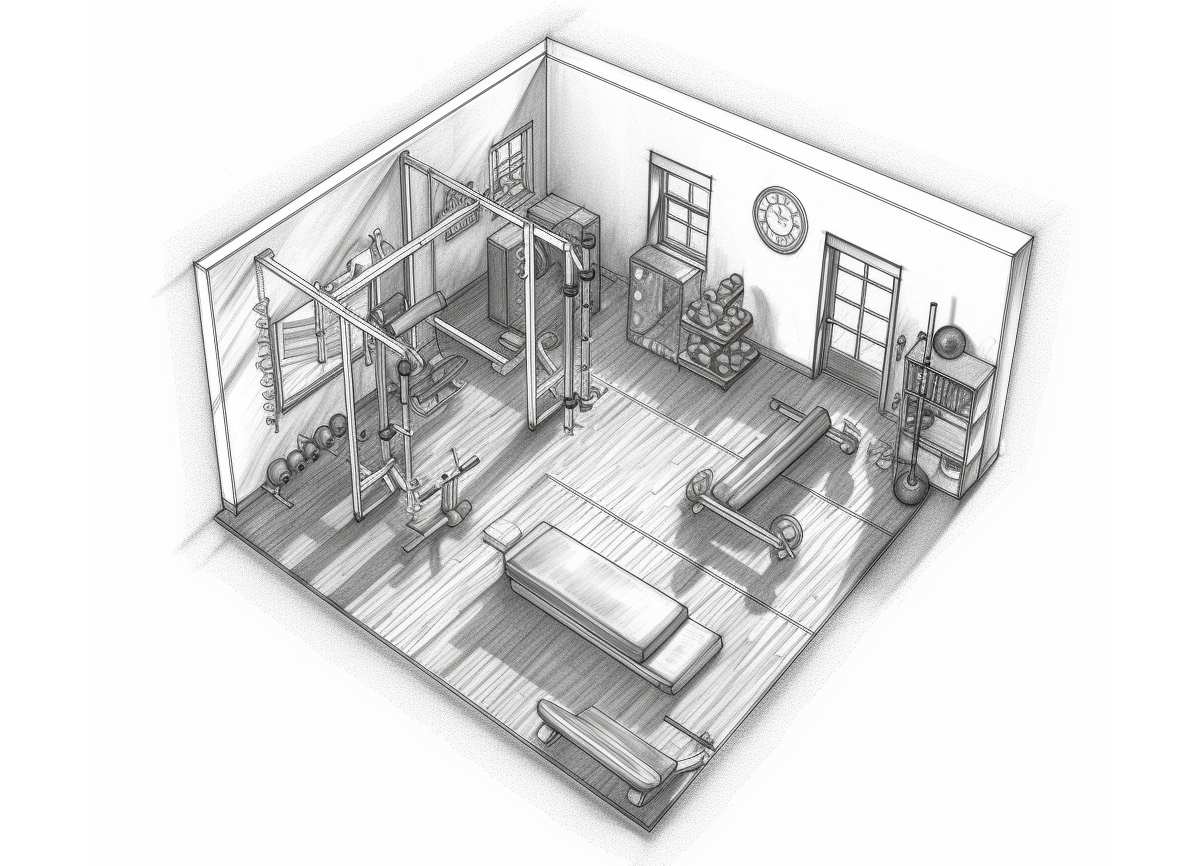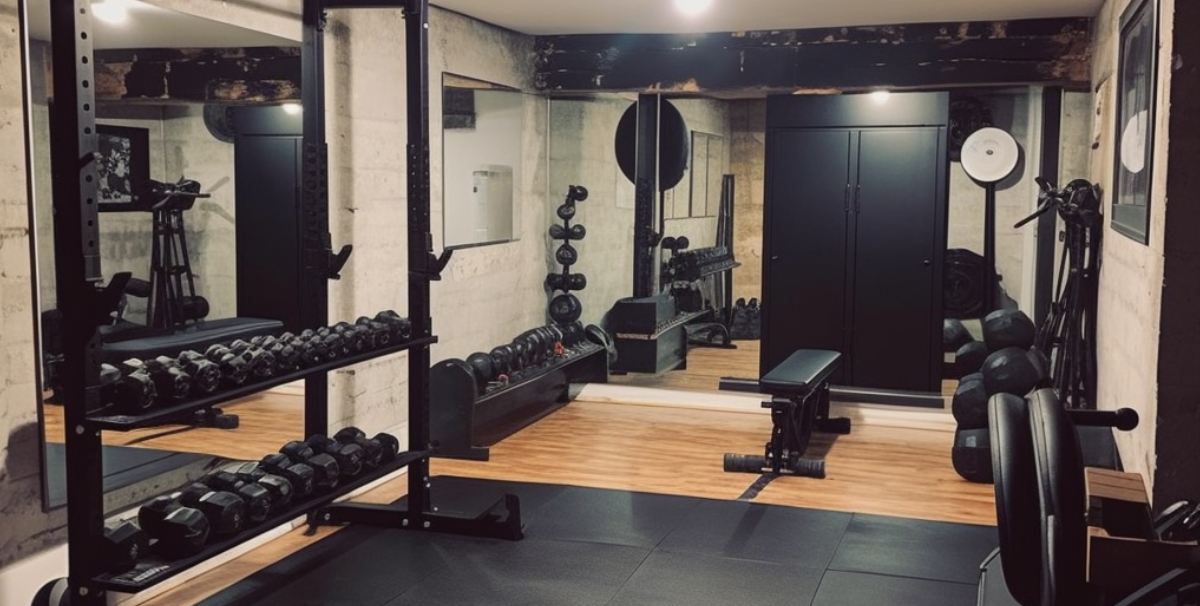Are you fed up with costly gym subscriptions or finding it tough to carve out time for exercise? Ever considered transforming that vacant spot in your basement into your very own workout space? If that’s the case, you’ve come to the right place.
Transforming your unfinished basement into a home gym involves:
- Creating the proper ventilation and adequate lighting.
- Appropriate flooring.
- Waterproofing.
- Choosing equipment wisely.
- Optimal use of space.
- The Budget.
Studies have shown that having a well-planned workout space at home can really boost our healthy habits.
So, let’s roll up our sleeves, and I’ll walk you through how to transform your basement into your very own personal gym.
Cleaning, Organizing, and Measuring
Decluttering remains the first step in any effort toward making your basement functional and spacious.
Donate old but usable items to any local charities that might accept them. Your local Salvation Army or Goodwill may even arrange pickup of things to save you trouble. Items worn beyond use should head straight to the bin, where they can be recycled or disposed of properly.
Organize the space so that only essential items remain. Move items you don’t need in the basement to other parts of the house. Old furniture can be refurbished for different rooms, while machinery may go to the garage or store room.
Grab a tape and find the dimensions of your basement along all sides. These dimensions will help decide what workout equipment is suitable. Make an accurate measurement of the ceiling’s height. Power racks and home gym units typically stand taller than most people, and you’ll need the additional headspace if they’re part of your exercise regimen.
Wall and Paint Color
Putting in Temporary Walls
Consider putting up some temporary walls to add sections and segments to your basement gym. Free-standing walls with girth and stability can double up as wall storage for lighter equipment. Portable room dividers bring both aesthetics and style to any space.
However, you should consider temporary walls carefully before adding them. Small basements can end up being cramped for space with additional structures in the room.
Painting the Basement Walls
The next step is to proceed and decide what color, palette, and type of paint you want for the walls. Consider adding washable paint to exposed walls that allow easier cleaning.
When choosing colors, remember that you’ll have to look at your basement walls regularly during workouts. Pick colors that are easy on the eyes.
Ventilation and Lighting
Lighting
The right lighting will allow you to work out comfortably regardless of the time of the day. Considering lighting for basement gyms should go beyond luminance and visibility. Try getting recessed lighting that goes into the walls and ceiling without wasting valuable space.
Ventilation
Clean and maintain existing vents or air inlets that may already be present in your basement. In most cases, constructing new windows is not possible. Free-standing or wall-mounted fans serve as good alternatives for better air circulation and ensuring a fresh environment.
The Floor and Ceiling
Installing Gym Flooring
Ditch the tiles and wooden panels when it comes to gym flooring. Tiling may break or crack when you place or drop barbells and other heavy equipment on them. Wooden floors look fantastic but remain vulnerable to wear and tear over time.
Rubber floors remain the best alternative for any workout area, regardless of whether it’s your basement or balcony. They absorb impact, are easy to clean, and come in various thicknesses, quality, and aesthetics.
Painting the Ceiling
Your ceiling paint can be a color that complements or matches the wall.
Choose somber and lighter shades that brighten up the space. Think of practical cleaning and maintenance needs over aesthetics in this case.
Basement ceilings are usually lower than in average rooms, so repainting and cleaning are easier.
Basement Waterproofing
Sealing unnecessary openings in your plumbing is a good step towards waterproofing your basement before bringing in the workout equipment.
While painting walls and ceilings, consider waterproof or acrylic paints that prevent moisture from seeping through and remain easier to wipe. Include waterproof rubber flooring and moisture-resistant materials on your walls and shelves too.
Choosing the Right Gym Equipment
Home Gym Systems
Consider home gyms that offer a variety of exercises and movements on a single machine. These systems are designed to occupy less space while providing a wide variety of exercises.
Space efficiency helps you optimize the available space in your basement. And the variety of exercises includes everything from cardio to strength conditioning within a few square feet.
Bench
If home gyms are beyond your budget, ensure that you invest in a proper bench. Benches do not hog up floor space but offer versatility for multiple exercises. Whether you’re performing a simple dumbbell press or a Bulgarian split squat, it’s all possible.
Weights
Weights give you mobility and the ability to customize your workout. All you need is the space to stand or sit on a chair. That makes it perfect for basements where existing equipment may cramp up the space.
Free weights also promote more functional workouts because lifting and wielding them comes naturally to you.
Mirrors
Putting up mirrors is a must for your basement gym. What you lack in physical space, you can make up with proper form and movement. Mirrors allow you to track your progress live and make corrections to form even as you continue working out.
They’re also affordable and easy to maintain compared to gym equipment that costs more depending on quality. Mirrors also help make your home gym appear bigger and more spacious. Plus, they improve visibility and luminance by reflecting your lighting setup.
Bands
Resistance bands are simple workout gears that are budget-friendly, easy to operate, and super portable. These qualities make them perfect additions to basement gyms.
Bands are also versatile enough to use without much wiggle room. And whatever space you have left after a home gym system or bench is enough.
Also, there are no worries about storage because bands can hang or fold into any available space.
Layout

Once you’ve chosen the equipment for your basement gym, the correct placement and arrangement are key to ensuring a healthy workout space.
You can push home gym systems into corners where they can sit permanently. Ensure the handlebars or bands do not extend onto the wall or ceiling when you work out.
Leave additional open space on the rubber mats for training with free weights and movement.
Invest in vertical racks and posts that can hold up your dumbbells and weights. Placing them on the floor will occupy extra space. Arran
Check out our article on Home Gym Space Requirements
Storage
Proper storage and efficient use of space are crucial in ensuring your gym remains functional and enjoyable.
- Go for as much vertical storage as possible. Adjustable shelves can hold your yoga blocks and kettlebells. Vertical racks hold all your dumbbells in the correct position, ensuring safety and additional space for other gear.
- Wall mounts are your ideal storage designs if your basement offers less space. Pegboards can hold lighter equipment like bands, hooks, and ropes. Heavy brackets may provide better storage for weight plates ensuring more floor space.
- Choose furniture that comes with storage components. Ottoman cubes will work for seated dumbbell curls while allowing storage inside. Some workout benches come with lids and empty compartments inside.
- Install overhead storage wherever possible. Basements are already cramped for space. Anything that can be stored above the ground allows you to enjoy extra space for movement.
The Budget
All these ideas and strategies for your basement gym rely on the funds available to execute them. Considering the additions, improvements, and installations you need, formulate a proper budget before you begin the transformation.
Upscale rubber floors (Horse Stall Mats) will improve your aesthetics but add substantially to the final bill. Affordable rubber tiles may look less nice, but they will serve the purpose. Likewise, every other tip in this guide may incur higher or lower costs depending on the variety you choose.
Plan ahead, consult experts, and compare prices to ensure your basement gym materializes on a realistic budget.




